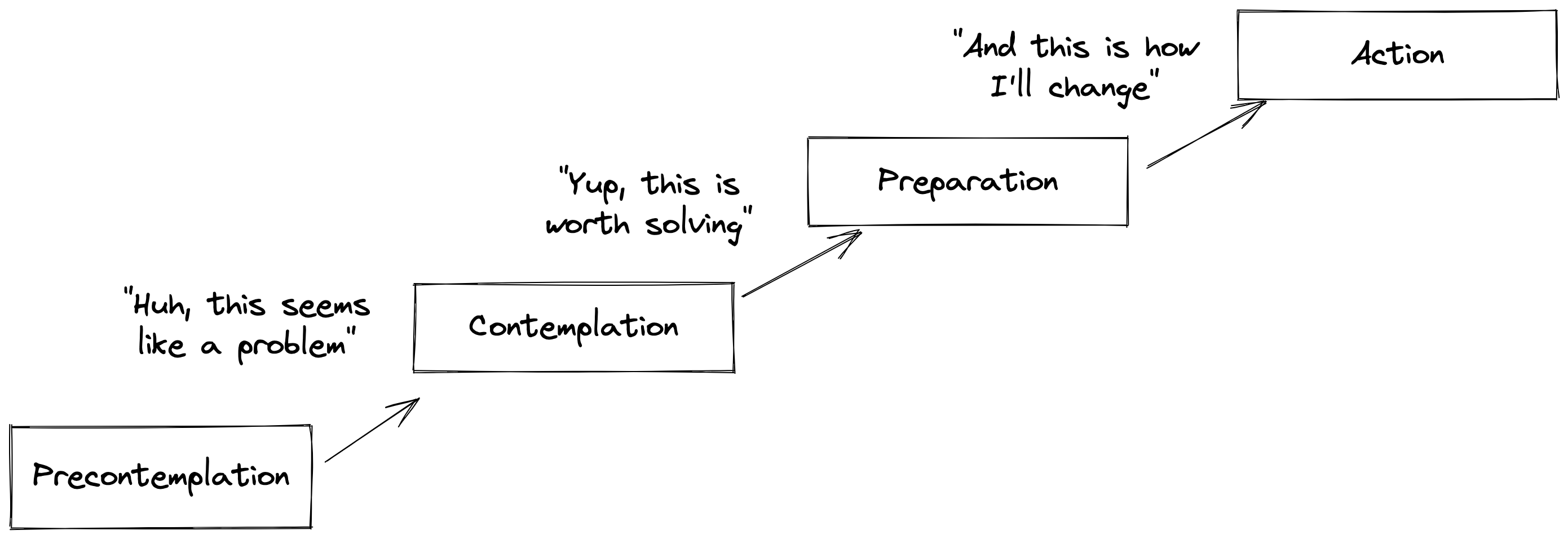A useful mental model for reasoning about behavior change is the Transtheoretical model – sometimes also known as the “Stages of Change” model.
This model describes the phases of human behavior change:
Precontemplation (“not ready”) – “People are not intending to take action in the foreseeable future, and can be unaware that their behaviour is problematic”
Contemplation (“getting ready”) – “People are beginning to recognize that their behaviour is problematic, and start to look at the pros and cons of their continued actions”
Preparation (“ready”) – “People are intending to take action in the immediate future, and may begin taking small steps toward behaviour change”
Action – “People have made specific overt modifications in modifying their problem behaviour or in acquiring new healthy behaviours”
Maintenance – “People have been able to sustain action for at least six months and are working to prevent relapse”
Termination – “Individuals have zero temptation and they are sure they will not return to their old unhealthy habit as a way of coping”
From this description, you can tell that the model is framed for decisions of the form “stop doing something bad” – e.g. smoking cessation. However, it’s also applicable to more value-neutral changes, such as moving between cities, switching jobs, etc.
My favorite aspect of the transtheoretical model is its separation of “precontemplation”, “contemplation”, and “preparation” as distinct phases. I’ll describe by way of contrast to a more naive model of change. An intuitive (though, I’d argue, incorrect) model of behavior change is the two step process of “decide” and “act”. That is, you consciously become aware of a decision that needs to me made, your brain crunches through the aspects of a decision, leading to an outcome that you act upon. “Decide and act” is not what most people do for important decisions, and is rarely successful for behavior change. Perhaps for trivial decisions (what shirt to wear today, what to have for breakfast, etc.), “decide and act” is a close-enough approximation. For bigger decisions or more radical life-altering changes, I think the addition of “preconcemplation” and “contemplation” to the model is significant.

“Precontemplation” is the subconscious process of realizing that a change needs to be made at all. “Contemplation” is the conscious realization that a change is necessary. Only then do we actually get to “preparation” – choosing what to actually do.

“Decide and act” presupposes the necessity of the decision. The transtheoretical model acknowledges that deciding to decide is part of the whole process – and starts subconsciously. Furthermore, the separation of “contemplation” and “preparation” acknowledges that it’s OK to separate deciding to decide from the contents of the decision.
Consider the example of deciding to move to a new city. Precontemplation gets you to the point of realizing that there’s something about your current location that you dislike, or something about another city that has begun to appeal to you. Contemplation is the conscious decision around “is it worth uprooting my life to go to another city?” Preparation gets into the logistics of decision: which city, when to move, do you need to look for a new job in that city, etc. Action is renting a moving van, packing up your things, signing a lease in the new city. Maintenance is establishing new habits in the new city and settling in.
Note that the process can end at (roughly) any phase: precontemplation could end with you finding something in your current city that appeals to you enough subconsciously to put the unease at bay; contemplation or preparation could result in you realizing that moving is infeasible, for one reason or another. And so on.
The process can also return to previous phases. The model calls this “relapse” – the return from the “action” or “maintenance” phase to a previous phase. This occurs frequently in less “sticky” examples than moving cities – e.g. quitting a diet plan, giving up on an exercise schedule, resuming smoking after attempting cessation.

One failure mode I find interesting is premature preparation. “Decide and act”, as mentioned earlier, presupposes the necessity of the decision. “Decide and act” is essentially premature preparation. We skipped the contemplation phases, and jumped right to “make a decision”. Without adequate contemplation, preparation often leads to decisions of the form “I need to do something; This is something; I should do this”. This is not a great algorithm for quality decisions.
Contemplation builds an internal justification for the behavior change, making it easy to follow through with the action phase. In precontemplation/contemplation, we develop a “why” for making a change; preparation is merely the “how”. Jumping to preparation can be more comfortable, since it feels more immediately tangible, but has the failure mode of flailing decisions that don’t stick.
Cover Image: Central Park, NYC